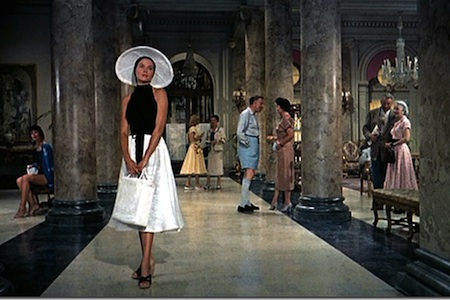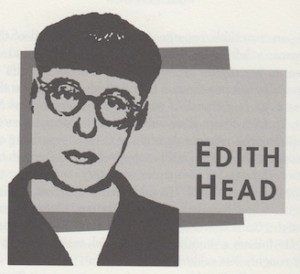Born: October 28, 1898, San Bernardino, CA
Died: October 24, 1981, Hollywood, CA
She raised costume design to the level of high art.
—Ally Acker
To find temporary work in the summer of 1923, Stanford alumna Edith Head wiggled her way into Paramount’s wardrobe department by falsely stating that she had experience as a sketch artist. She wound up staying at the studio for forty-four years. Her eight Oscars, from a record-setting thirty-four nominations, highlighted one of Hollywood’s most illustrious careers, and her remarkable influence carried over into the fashion world.
In the 1920s, Head became thoroughly acclimated to the politics of the studio system, often battling with the Production Code censors over the suggestive costumes she created for sex goddesses Clara Bow and Jean Harlow. Head still managed to emphasize the best assets of these “bad girls” by creating gowns that hinted at the famous forms that lay beneath them. Her clever use of loose folds around the drooping neckline of Harlow’s dresses playfully moved with the actresses’ buxom physique. After several years assisting others and gaining notice in early sound features, Edith Head’s first shot as a credited costume designer was She Done Him Wrong (1933), a Mae West vehicle that became an overnight sensation and topped the box office at the height of the Great Depression. Although Head was forced to incorporate the diamond necklaces and velvet bustiers that West favored from earlier vaudeville performances, she soon began to break with the practice of adopting gaudy stage accoutrement for the screen.
Throughout her long career, Edith Head would repeatedly set style through movies. The sarong she designed for beauty Dorothy Lamour in The Jungle Princess (1936) created a nationwide fashion trend. She continued to dress Lamour for several years, handling the traveling apparel in most of her Road pictures with Bob Hope and Bing Crosby. Head’s tailored suits, worn by top actresses Bette Davis in All About Eve (1950) and Elizabeth Taylor in A Place in the Sun (1951), did for women’s wear what Max Factor did for makeup.
The conservative-but-sexy Grace Kelly of Alfred Hitchcock’s Rear Window (1954) and To Catch a Thief (1955) is the trademark look of Edith Head. Her prep-school aesthetic dominated fifties moviemaking, seen best in the sleek sweaters and stretch stirrup pants of the decade. Hitchcock provided her more opportunities in the outfitting of Shirley MacLaine, Doris Day and Kim Novak in The Trouble with Harry (1955), The Man Who Knew Too Much (1956) and Vertigo (1958), respectively. She would work for the Master of Suspense again in Marnie (1964), Torn Curtain (1966), Topaz (1969) and his final film, Family Plot (1976). In fact, Head clashed and collaborated with some of Hollywood’s most skillful and particular directors: Billy Wilder, John Ford, Cecil B. DeMille and Bob Fosse. She moved from genre to genre easily, draping the characters of classic film noir thrillers, westerns and period dramas.
Edith Head was also the driving force behind the glamour of the Academy Award ceremonies. She was a special adviser for the first televised Academy Awards, then dressed hundreds of stars for the event for nearly twenty-five years. According to a famous anecdote, Joan Crawford commissioned Head to prepare two identical gowns from the same pattern, one in black and one in beige. Upon seeing the preceding presenter appear in ebony, Crawford opted for the beige and changed dresses while waiting in the wings.
As the first woman to head a design department in a major studio, Head often got screen credit for gowns that were designed by others, and her name was attached to many films she had little influence over. Audrey Hepburn dragged her own outfits to the set of Sabrina (1954), and the Givenchy dresses were mistaken as Head’s own creations. Nevertheless, she was the rare production specialist known to women by name, and her credits became more prominent as her successes multiplied.
The name on the screen soon became the name on the label, as Head was recognized in every home. She won work outside of Hollywood, designing uniforms for international airlines, creating Vogue patterns that rivaled the latest Paris fashions, appearing on Art Linkletter’s television show to give hints to American housewives and writing columns in many of the day’s top fashion magazines. She also authored self-help books for those without her gifts for color coordination.
With so many book deals and TV appearances, many studio executives felt she was hogging the spotlight and demoralizing the hundreds of other production crew members. Her extreme popularity inflated her ego, and during the 1960s she was a feisty collaborator. Paramount punished her in 1967, by allowing her contract to expire without offering a renewal. At her departure, she had been a Paramount employee longer than anyone else in the studio’s history except its founder, Adolph Zukor.
Head’s undeniable talent was quickly employed by others. Her work for The Sting (1973) launched male fashion trends in the early 1970s. On more than 750 films, spanning six decades, Head’s work endured. The proof: her final designs, for Steve Martin’s Dead Men Don’t Wear Plaid (1982), utilized styles she had created for many of the thirties and forties clips featured in the movie.
To read all the republished articles from ‘The Film 100,’ as well as the complete list of 100 most influential people in the history of the movies, go to Reintroducing the Film 100 here on Keyframe.





